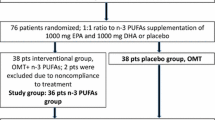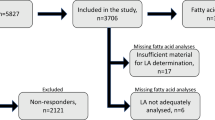Abstract
Objectives
Although previous data suggested that only doses of 4 g/day or higher of n-3 polyunsaturated fatty acids (PUFA) have had a beneficial effect in the prevention of atherosclerosis and cardiovascular diseases, the GISSI-Prevenzione Study in a 3-year trial showed that 1 g/day reduced total and cardiovascular mortality in over 11,000 post-infarction patients. The aim of this study was to investigate the time course and the extent of incorporation of n-3 fatty acids in plasma and blood cells after 1 g/day of n-3 PUFA, the dose effective in the GISSI-Prevenzione in comparison with higher doses.
Methods
Thirty-six healthy volunteers were given 1, 2 and 4 g/day of n-3 PUFA ethyl esters for 12 weeks, followed by a 4-week washout. Blood was collected at weeks 0, 1, 2, 4, 8, 12 and 16 and used for lipid profile analysis and measurement of fatty acid composition in plasma phospholipids, platelets and mononucleates.
Results
Total n-3 PUFA increased by 2.0-, 2.2- and 2.9-fold versus baseline after 12-week treatment with 1, 2 and 4 g respectively. A statistically significant raise of total n-3 PUFA was seen in platelets and mononucleates. Among individual n-3 PUFA, 22:5 n-3 was enriched early and dose dependently in plasma phospholipids, platelets and mononucleates; the raise of 22:6 n-3 was less marked especially in platelets and mononucleates.
Conclusions
One gram per day of n-3 PUFA induces fast (within 1 week) and striking changes in blood composition of PUFA that may well explain their beneficial effects against cardiovascular diseases.




Similar content being viewed by others
References
Bang HO, Dyerberg J (1972) Plasma lipids and lipoprotein in Groenlandic west coast Eskimos. Acta Med Scand 192:85–94
Dyerberg J, Bang HO, Stoffersen E, Moncada S, Vane JR (1978) Eicosapentaenoic acid and prevention of thrombosis and atherosclerosis? Lancet 2:117–119
Mori TA, Beilin LJ, Burke V, Morris J, Ritchie J (1997) Interactions between dietary fat, fish, and fish oils and their effects on platelet function in men at risk of cardiovascular disease. Arterioscler Thromb Vasc Biol 17:279–286
James MJ, Gibson RA, Cleland LG (2000) Dietary polyunsaturated fatty acids and inflammatory mediator production. Am J Clin Nutr 71:343S–348S
Kolanowski W, Swiderski F, Berger S (1999) Possibilities of fish oil application for food products enrichment with ω-3 PUFA. Int J Food Sci Nutr 50:39–49
Connor WE (2000) Importance of n-3 fatty acids in health and disease. Am J Clin Nutr 71:171S–175S
Connor WE, De Francesco CA, Connor SL (1993) N-3 fatty acids from fish oil. Effects on plasma lipoproteins and hypertriglyceridemic patients. Ann N Y Acad Sci 683:16–34
Calabresi L, Donati D, Pazzucconi F, Sirtori CR, Franceschini G (2000) Omacor in familial combined hyperlipidemia: effects on lipids and low density lipoprotein subclasses. Atherosclerosis 148:387–396
Van Dam M, Stalenhoef AFH, Wittekoek J, Trip MD, Prins MH, Kastelein JJP (2001) Efficacy of concentrated n-3 fatty acids in hypertriglyceridaemia: a comparison with gemfibrozil. Clin Drug Invest 21:175–181
Nilsen DWT, Albrektsen G, Landmark K, Moen S, Aarsland T, Woie L (2001) Effects of a high dose concentrate of n-3 fatty acids or corn oil introduced early after an acute myocardial infarction on serum triacylglycerol and HDL cholesterol. Am J Clin Nutr 74:50–56
Siscovick DS, Raghunathan T, King I, Weinmann S, Bobvjerg VE, Kushi L, Cobb LA, Copass MK, Psaty BM, Lemaitre R, Retzlaff B, Knopp RH (2000) Dietary intake of long-chain n-3 polyunsaturated fatty acids and the risk of primary cardiac arrest. Am J Clin Nutr 71:208S–212S
Landmark K, Abdelnoor M, Urdal P, Kilhovd B, Borge N, Refvem H (1998) Use of fish oil appears to reduce infarct size as estimated from peak creatine kinase and lactate dehydrogenase activities. Cardiology 89:94–102
De Caterina R (1999) The inhibition of endothelial activation by unsaturated fatty acids. Lipids 34:S191–S194
GISSI-Prevenzione Investigators (1999) Dietary supplementation with n-3 polyunsaturated fatty acids and vitamine E after myocardial infarction: results of the GISSI-Prevenzione Trial. Lancet 354:447–455
Mancini M, Rubba P (2000) The Mediterranean diet in Italy. World Rev Nutr Diet 87:114–126
Folch J, Lees M, Sloane-Stanley GH (1957) A simple method for the isolation and purification of total lipids from animal tissues. J Biol Chem 226:497–509
Glass RL (1971) Alcoholysis, saponification and the preparation of fatty acid methylesters. Lipids 6:919–925
Lehman EL (1975) Nonparametrics: statistical methods based on ranks, 1st edn. Holden-Day Inc., San Francisco
Tremoli E, Maderna P, Marangoni F, Colli S, Eligini S, Catalano I, Angeli MT, Pazzucconi F, Gianfranceschi G, Davi G, Stragliotto E, Sirtori CR, Galli C (1995) Prolonged inhibition of platelets aggregation after n-3 fatty acid ethyl ester ingestion by healthy volunteers. Am J Clin Nutr 61:607–613
Marangoni F, Angeli MT, Colli S, Eligini S, Tremoli E, Sirtori CR, Galli C (1993) Changes in n-3 and n-6 fatty acids in plasma and circulating cells of normal subjects, after prolonged administration of 20:5 (EPA) and 22:6 (DHA) ethyl esters and prolonged washout. Biochim Biophys Acta 1210:55–62
Yaqoob P, Pala HS, Cortina-Borja M, Newsholme EA, Calder PC (2000) Encapsulated fish oil enriched in alfa-tocopherol alters plasma phospholipid and mononuclear cell fatty acid compositions but not mononuclear cell functions. Eur J Clin Invest 30:260–274
Crawford MA (2000) Commentary on the workshop statement. Prostaglandins Leukot Essent Fatty Acids 63:131–134
Simopoulos AP, Leaf A, Salem N Jr (2000) Statement on the essentiality of and recommended dietary intakes for omega-6 and omega-3 fatty acids. Prostaglandins Leukot Essent Fatty Acids 63:119–121
Kremer JM (2000) N-3 fatty acid supplements in rheumatoid arthritis. Am J Clin Nutr 71:349S–351S
De Caterina R, Basta G (2001) N-3 fatty acids and the inflammation response-biological background. Eur Heart J 3[Suppl D]:42–49
Nordoy A (2001) Fish consumption and cardiovascular disease. Eur Heart J 3[Suppl D]:4–7
Rissanen T, Voutilainen S, Nyyssonen K, Lakka TA, Salonen JT (2000) Fish oil-derived fatty acids, docosahexaenoic acid and docosapentaenoic acid, and the risk of acute coronary events. The Kuopio ischemic heart disease risk factor study. Circulation 102:2677–2679
Albert CM, Campos H, Stampfer MJ, Ridker MJ, Manson JE, Willett WC, Ma J (2002) Blood levels of long-chain n-3 fatty acids and the risk of sudden death. N Engl J Med 346:1113–1118
Iso H, Rexrode KM, Stampfer MJ, Manson JE, Colditz GA, Speizer FE, Hennekens CH, Willett WC (2001) Intake of fish and omega-3 fatty acids and risk of stroke in women. JAMA 285:304–312
Hu FB, Bronner L, Willett WC, Stampfer MJ, Rexrode KM, Albert CM, Hunter D, Manson JE (2002) Fish and omega-3 fatty acid intake and risk of coronary heart disease in women. JAMA 287:1815–1821
Paganelli F, Maixent JM, Duran MJ, Parhizgar R, Pieroni G, Sennoune S (2001) Altered erythrocyte n-3 fatty acids in Mediterranean patients with coronary artery disease. Int J Cardiol 78:27–32
Christensen JH, Skou HA, Fog L, Hansen VE, Vesterlund T, Dyerberg J, Toft E, Schmidt EB (2001) Marine n-3 fatty acids, wine intake, and heart rate variability in patients referred for coronary angiography. Circulation 103:651–657
Blonk MC, Bilo HJG, Nauta JJP, Popp-Snijders C, Mulder C, Donker AJM (1990) Dose-response effects of fish-oil supplementation in healthy volunteers. Am J Clin Nutr 52:120–127
Li B, Birdwell C, Whelan J (1994) Antithetic relationship of dietary arachidonic acid and eicosapentaenoic acid on eicosanoid production in vivo. J Lipid Res 35:1869–1877
Akiba S, Murata T, Kitatani K, Sato T (2000) Involvement of lipoxygenase pathway in docosapentaenoic acid-induced inhibition of platelet aggregation. Biol Pharm Bull 23:1293–1297
Véricel E, Calzada C, Chapuy P, Lagarde M (1999) The influence of low intake of n-3 fatty acids on platelets in elderly people. Atherosclerosis 147:187–192
Abeywardena MY, McLennan PL, Charnock JS (1991) Changes in myocardial eicosanoid production following long-term dietary lipid supplementation in rats. Am J Clin Nutr 53:1039S-1041S
Mabile L, Piolot A, Boulet L, Fortin LJ, Doyle N, Rodriguez C, Davignon J, Blache D, Lussier-Cacan S (2001) Moderate intake of n-3 fatty acids is associated with stable erythrocyte resistance to oxidative stress in hypertriglyceridaemic subjects. Am J Clin Nutr 74:449–456
Negretti N, Pérez MR, Walker D, O’Neill SC (2000) Inhibition of sarcoplasmic reticulum function by polyunsaturated fatty acids in intact, isolated myocytes from rat ventricular muscle. J Physiol 523:367–375
Kang JX, Leaf A (2000) Prevention of fatal cardiac arrhythmias by polyunsaturated fatty acids. Am J Clin Nutr 71:202S–207S
Leifert WR, Dorian CL, Jahangiri A, McMurchie EJ (2001) Dietary fish oil prevents asynchronous contractility and alters Ca2+ handling in adult rat cardiomyocytes. J Nutr Biochem 12:365–376
Leaf A (2001) The electrophysiological basis for the antiarrhythmic actions of polyunsaturated fatty acids. Eur Heart J 3[Suppl D]:98–105
Billman GE, Kang JX, Leaf A (1999) Prevention of sudden cardiac death by dietary pure omega-3 polyunsaturated fatty acids in dogs. Circulation 99:2452–247
McLennan PL, Bridle TM, Abeywardena MY, Charnock JS (1992) Dietary lipid modulation of ventricular fibrillation threshold in the marmoset monkey. Am Heart J 123:1555–1561
Charnock JS (1999) Fish oil supplemented diets and cardiac funtion in marmoset monkeys: a non-human primate model for the study of cardiac arrhythmia. Nutr Res 19:1429–1435
Christensen JH, Christensen MS, Dyerberg J, Schmidt EB (1999) Heart rate variability and fatty acid content of blood cell membranes: a dose-response study with n-3 fatty acids. Am. J Clin Nutr 70:331–337
Nair SSD, Leitch JW, Falconer J, Garg ML (1997) Prevention of cardiac arrhythmia by dietary (n-3) polyunsaturated fatty acids and their mechanism of action. J Nutr 127:383–393
Maggioni AP, Tavazzi A, Marchioli R, Tognoni G, Avanzini F, Roncaglioni C, on behalf of the GISSI group (2001) Perspectives on n-3 PUFA: primary prevention, antiarrhythmic effects, congestive heart failure. Eur Heart J 3[Suppl D]:106–109
Acknowledgements
Work partially supported by Pronova, Lysaker, Norway. The experiments were conducted according to the 1996 revision of the Declaration of Helsinki and with the Italian current laws.
Author information
Authors and Affiliations
Corresponding author
Additional information
Delia Di Stasi and Roberto Bernasconi contributed equally to this work.
Rights and permissions
About this article
Cite this article
Di Stasi, D., Bernasconi, R., Marchioli, R. et al. Early modifications of fatty acid composition in plasma phospholipids, platelets and mononucleates of healthy volunteers after low doses of n-3 polyunsaturated fatty acids. Eur J Clin Pharmacol 60, 183–190 (2004). https://doi.org/10.1007/s00228-004-0758-8
Received:
Accepted:
Published:
Issue Date:
DOI: https://doi.org/10.1007/s00228-004-0758-8




